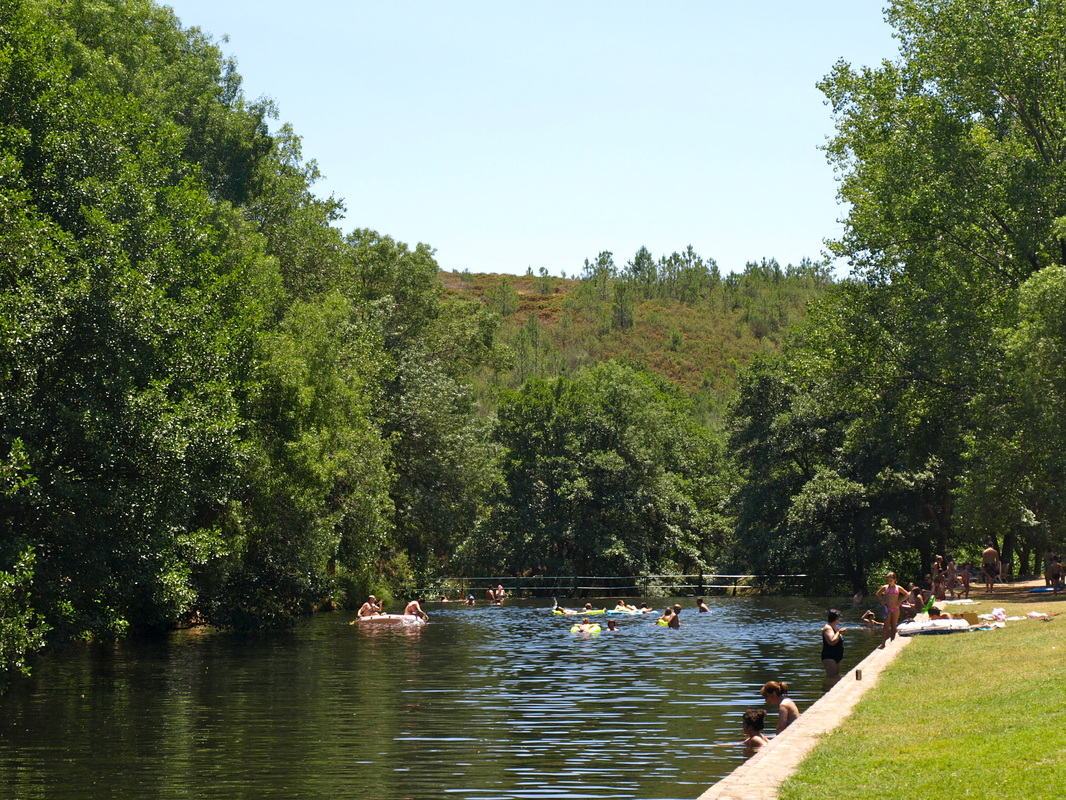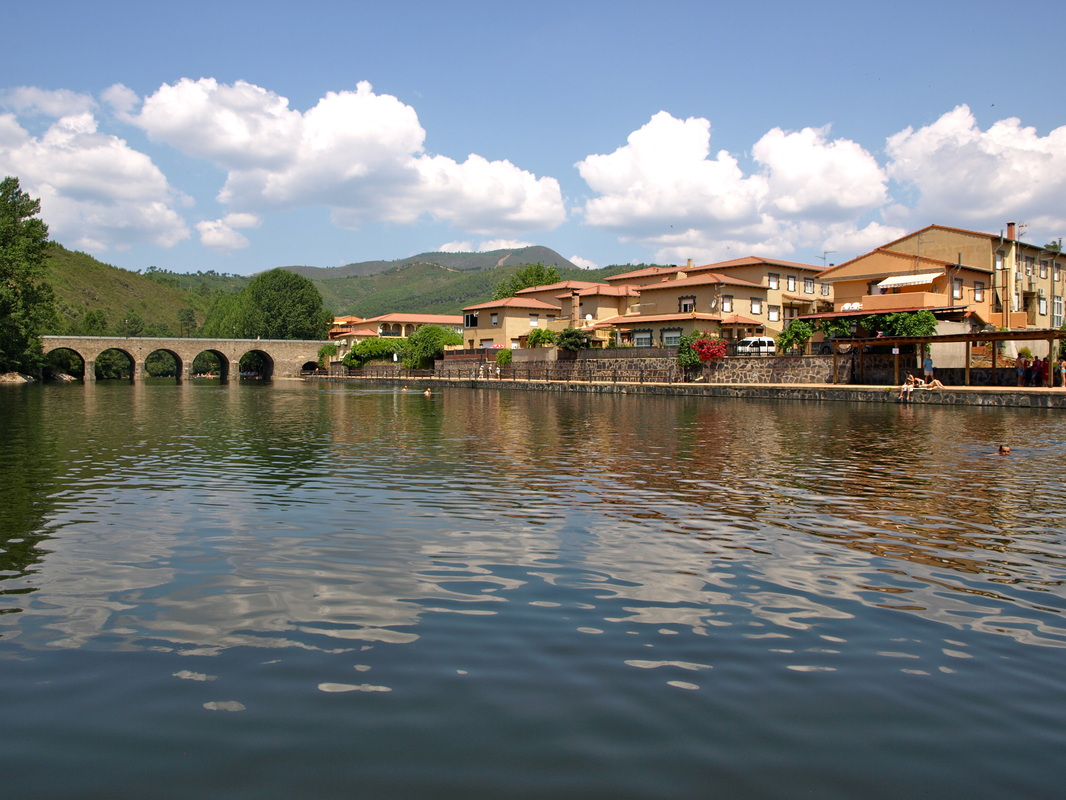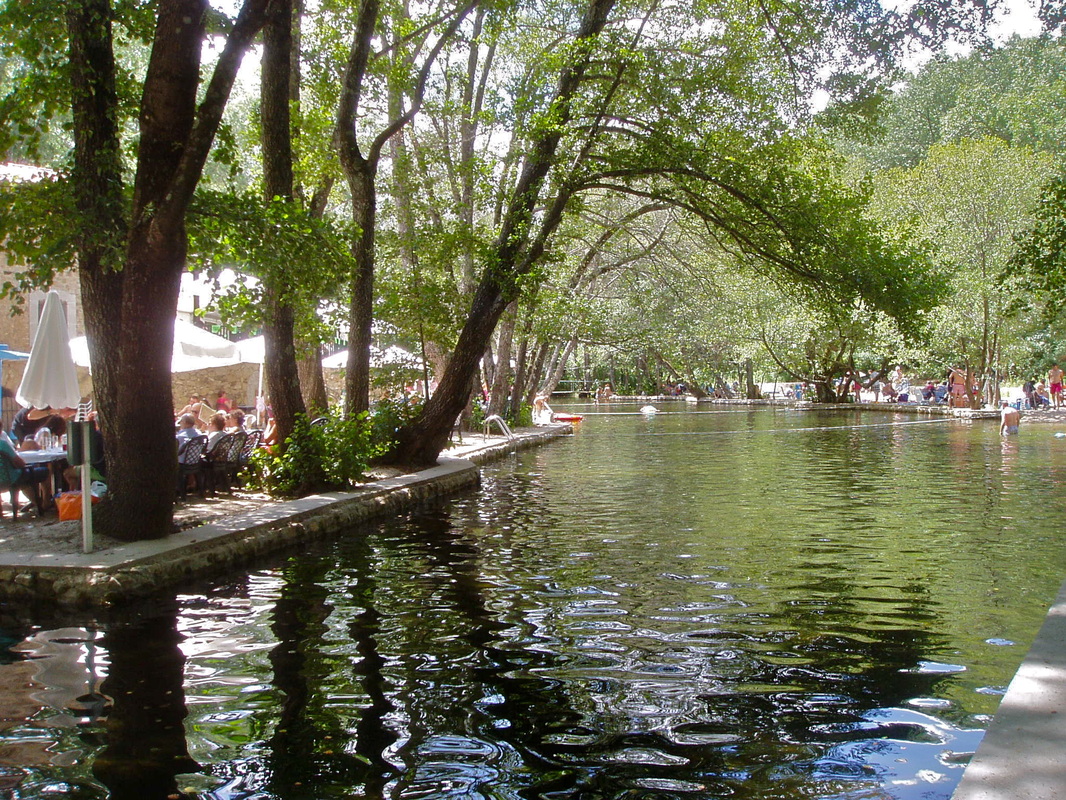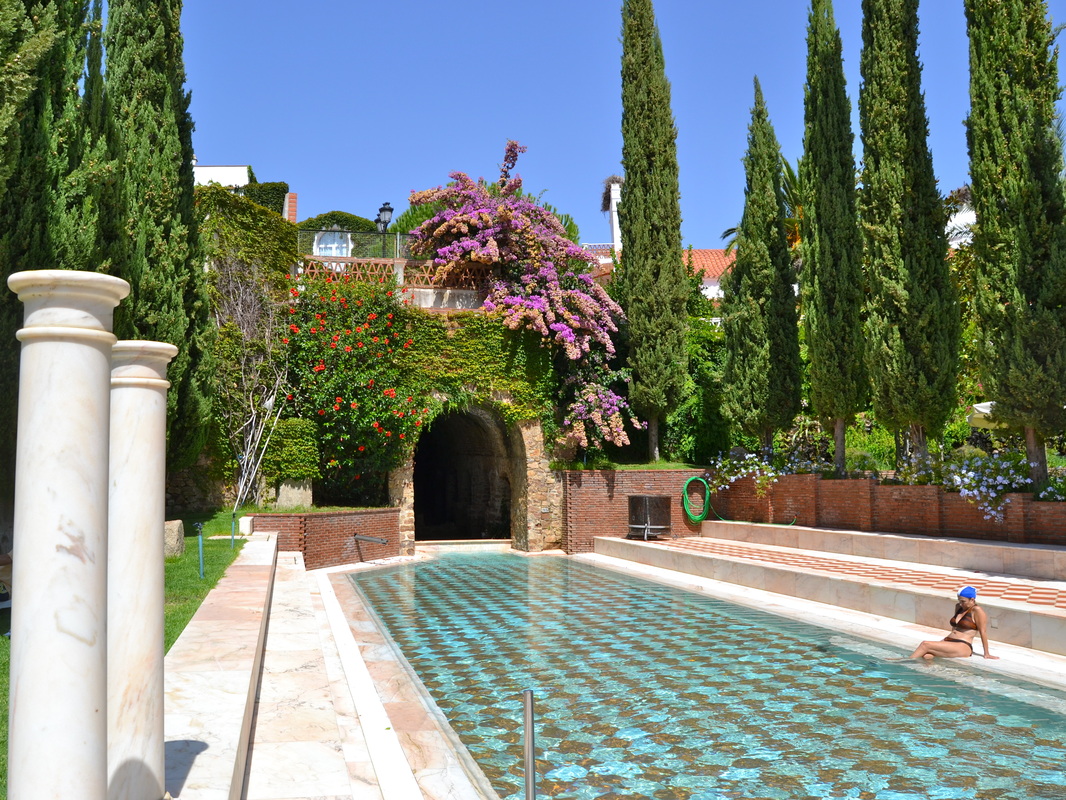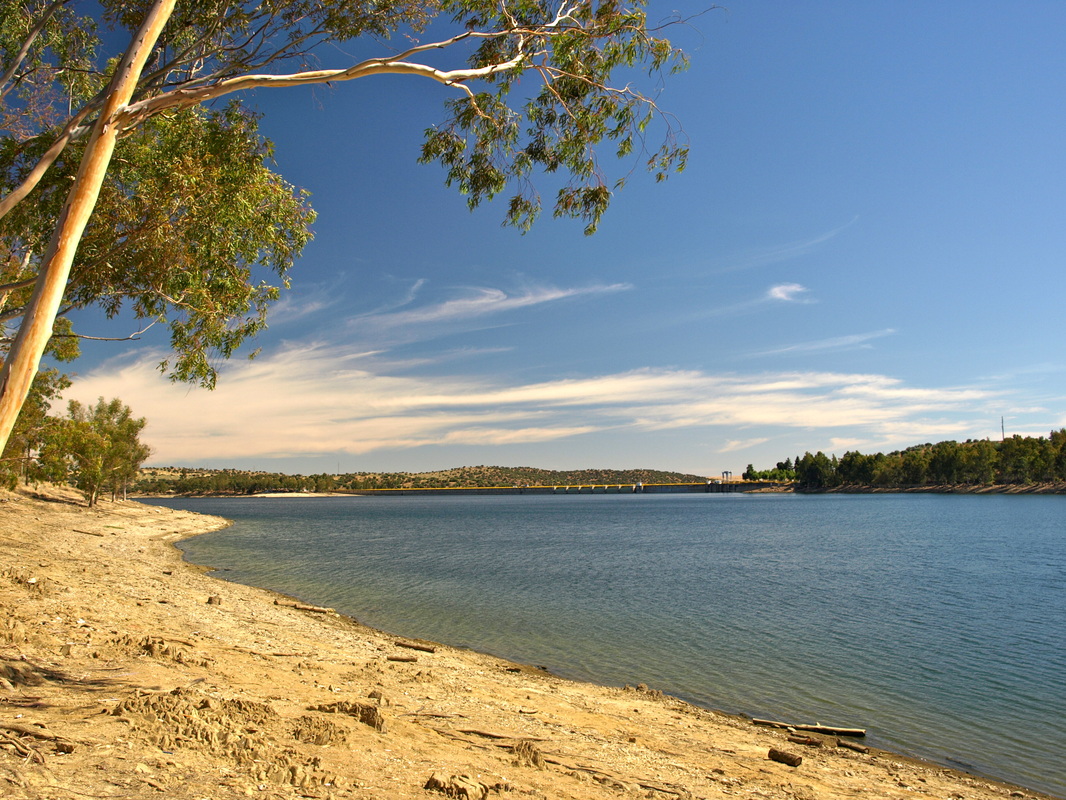Water — walk, swim, siesta
The statistic is rather incredible for those who have never been here but Extremadura contains more water than any other place in Spain and, it is said, more kilometres of ‘coastline’ than anywhere in Europe. That’s because Extremadura has many rivers, lakes and reservoirs. There are also ‘natural’ pools created where water flows slowly and swimming is possible in granite pools scooped out over millennia. Alternatively, a level river bed is lined with smooth, fairly even, river stones. The flow of water is controlled by lock gates. The gates are closed in June and the water rises to an average level which doesn’t change and allows safe swimming. Some water escapes the gates and keeps the pool clean. Near the end of September the gates are opened and the natural pool disappears. It’s ingenious.
The reason for this page on ‘water’ on a walking site is obvious to anyone who is tied to holidays in the summer months. Below is a list of places to walk near swimming opportunities. When it's 30ºC and still only 9.00am it is possible to walk, but it's so much nicer with the thought of slipping into cool water as soon as the walk is over! Both experiences enhance each other. Get up early, walk, then swim and siesta under the shade of a huge, leafy tree. Most natural pools and popular lakes have car parks, cafés, restaurants, toilets and other amenities. They are clean and natural so ... take the plunge ... but don’t forget your swim shoes.
The statistic is rather incredible for those who have never been here but Extremadura contains more water than any other place in Spain and, it is said, more kilometres of ‘coastline’ than anywhere in Europe. That’s because Extremadura has many rivers, lakes and reservoirs. There are also ‘natural’ pools created where water flows slowly and swimming is possible in granite pools scooped out over millennia. Alternatively, a level river bed is lined with smooth, fairly even, river stones. The flow of water is controlled by lock gates. The gates are closed in June and the water rises to an average level which doesn’t change and allows safe swimming. Some water escapes the gates and keeps the pool clean. Near the end of September the gates are opened and the natural pool disappears. It’s ingenious.
The reason for this page on ‘water’ on a walking site is obvious to anyone who is tied to holidays in the summer months. Below is a list of places to walk near swimming opportunities. When it's 30ºC and still only 9.00am it is possible to walk, but it's so much nicer with the thought of slipping into cool water as soon as the walk is over! Both experiences enhance each other. Get up early, walk, then swim and siesta under the shade of a huge, leafy tree. Most natural pools and popular lakes have car parks, cafés, restaurants, toilets and other amenities. They are clean and natural so ... take the plunge ... but don’t forget your swim shoes.
|
The Sierra de Gata has more natural pools than any other area.
To complement the six walks in my first book, the five in my second plus the four on this site there is a choice of 12 natural pools, listed from west to east: Valverde del Fresno, Eljas, San Martín de Trevejo, Acebo, Hoyos, Perlas del Puerto, Villasbuenas de Gata, Gata, Cadalso, Descargamania, Hernán Perez and Robledillo de Gata. Smaller pools, like Eljas and San Martín de Trevejo don’t have a café but the one at Hoyos has a restaurant and a barbecue. Las Hurdes, in the extreme north has eight natural pools. Listed from west to east, are Robledillo de Gata and Ovejuela, and close by is Pinofranqueado, a thriving resort in summer with the biggest natural pool imaginable, hotels, cafés and a camping site. The natural pool is created in the River de Los Angeles. North is Horcajo, with Casar de Palomero, Caminomorisco and Vegas de Coria further west. Las Mestas, is in the north with a restaurant, “La Olla” overlooking the river. The Valle del Ambroz has extensive forests, rivers that never run dry, ancient history and several natural pools. I haven’t walked much in this beautiful valley other than during the autumn months of each year. However, the area boasts five natural pools, listed from west to east: La Granja, Abadia, Casas del Monte, Segura de Toro and Gargantilla. The Valle del Jerte has the River Jerte itself but it also has one of the most famous natural pools — Los Pilones. Los Pilones is probably the most famous of the natural pools in Extremadura. I’ve paddled here but the water is colder than in the Sierra de Gata or Las Hurdes; it’s higher and the water is snow-melt. The Walk of the Cherry Thieves has Navaconcejo with full amenities where it is also pleasant to just swim in the Jerte in open countryside. Just north of Navaconcejo is Cabezuela del Valle with a lovely natural pool and cafés. The Sierra de Gredos and La Vera have numerous natural pools dotted around the area. Counting both books and this site, there are a total of 11 walks in this area and 11 natural pools. Listed from west to east: Garganta la Olla has two pools (top photo), one with a waterfall, Jaraiz de la Vera which is a huge pool with different levels for swimming and real sand for those who want the sand-in-sandwiches experience. Jaraiz has another pool a few minutes walk though the deciduous woods. Eastwards, there are pools at Aldeanueva de la Vera, two at Jarandilla de la Vera, Tornavacas, Guijo de Santa Barbara, Losar de la Vera, Garganta de Cuartos, Valverde de la Vera, Villanueva de la Vera and Madrigal de la Vera. Los Ibores and Las Villuercas are remote, unspoiled and have two lovely natural pools. In my first book there are three walks in this area and another three in the second book and there are two natural pools to complement these walks: listed from west to east: Castañar de Ibor and Cañamero. It's a lovely area — natural and peaceful. Further south, as streams dry up in the summer, there are big rivers, lakes and reservoirs. Proserpina complements the walk in my first book and is a favourite swimming place. On the south side of Mérida is Alange, Roman Spa Town, with its thermal waters. It also has a pretty pool set in the most beautiful lawns and gardens with exotic flowering climbers and bushes — a must after the walk in my book. It's open until November each year so that's a plus when other options shut down mid-September. Medellín, home town of Hernán Cortés, stands on a bend in the Guadiana. The river bank nearest the town is covered in summer cafés and restaurants while everyone swims in the water to work up an appetite. Highly recommended! Further east on the Guadiana are the reservoirs of Orellana with its small yachting marina. During the summer there is a café and ice cream outlets with evening open-air concerts and holiday activities. My second book has a super little walk just near Orellana. Zújar with its quiet charm is south of Orellana and there is a lovely natural pool tucked away below the dam. Every village has a pool, open every day from 12.00 to 21.00 during mid-June to mid-September. These come with shady trees, cafés, changing facilities and a lifeguard. One of the nicest is at Montánchez with a good café/restaurant and a view of the castle as you swim. However, nothing beats swimming in nature, but just a few words, natural pools are shallow but lakes can be deep. Take care! Top photo: One of the natural pools outside Garganta del Olla in July |
